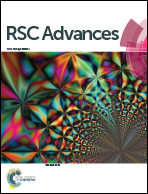Nitrogen-doped porous graphene–activated carbon composite derived from “bucky gels” for supercapacitors†
Abstract
A simple method has been developed to prepare nitrogen-doped porous graphene–activated carbon (AC) composites as high-performance electrode materials for supercapacitors. The graphene-based “bucky gels”, prepared by simple mixing and grinding of graphene in ionic liquids (ILs), are carbonized to form an “untractable char” intermediate product, and finally converted to the nitrogen-doped porous graphene–AC composite by chemical activation using KOH. Results demonstrate that the introduction of graphene sheets into the composite not only effectively enhance the specific surface area and conductivity of graphene–AC composite, but also enlarge the pore size in the electrode material compared with pure AC. In addition, the nitrogen-doping can further improve the kinetics for both charge transfer and ion transport throughout the electrode. It's found that the composite has a large specific surface area of 2375.2 m2 g−1, and also contains plenty of mesopores and appreciable nitrogen-doping amount. It exhibits a specific capacitance up to 145 F g−1 at 20 mV s−1 in 6 M KOH electrolyte, and the specific capacitance decreases by only 1.6% after 5000 cycles. This kind of nitrogen-doped composite represents an alternative promising candidate as electrode material for supercapacitors.


 Please wait while we load your content...
Please wait while we load your content...